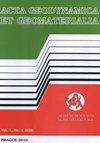巴基斯坦西北喜马拉雅Potwar高原喜马拉雅山麓(东部盐岭)古应力和露头断裂分析
IF 0.8
4区 地球科学
Q4 GEOCHEMISTRY & GEOPHYSICS
引用次数: 0
摘要
盐岭(SR)是一个ENE-WSW走向的断层弯曲褶皱,形成巴基斯坦喜马拉雅褶皱和逆冲带的山脉前缘。本研究是在东部盐岭(ESR)进行的,目的是利用断裂数据确定由还原应力张量反演的古应力。褶皱的表面形态主要由始新世石灰岩形成,这些石灰岩提供了可用于运动学和动力学分析的最佳节理表面暴露。我们在野外采用了经典的圆形盘存法,并从始新世萨克萨石灰岩的7个位置(露头站)收集了方位数据(倾角、方向和走向)。研究区存在三个突出的断裂趋势,即FS-1;(E-W),FS-2;(ENE-WSW)和FS-3;(NNE-SSW)。为了进行应力分析和数据处理,我们使用了Delvaux和Sperner(2003)的张量程序,并用右二面体法计算了七个应力场。在所有应力张量中,主应力轴的方向(Γ1、Γ2、Γ3)和应力比(R)表示Γ1(Shmax)和Γ2是亚水平的,而Γ3是垂直的。古应力研究结果表明,该区属于一个挤压区,其走向为NNE-SSW。研究表明,在波特瓦尔高原,1的发展或多或少与SRT和其他相关结构的趋势垂直。本文章由计算机程序翻译,如有差异,请以英文原文为准。
Paleostress and outcrop fracture analysis along Himalayan Foothills (Eastern Salt Range), Potwar Plateau, NW Himalaya, Pakistan
The Salt Range (SR) is an ENE-WSW trending fault bend fold that form the range front of the Himalayan fold and thrust belt in Pakistan. The research is carried out in the Eastern Salt Range (ESR) with the objective to determine the paleostress inversion from reduced stress tensors by using fracture data. The surface morphology of the fold is predominantly shaped by Eocene limestone that provide best exposure of joint surfaces that can be used for kinematic and dynamic analysis. We adopted a classical circle inventory method in the field and collected orientation data (dip amount, direction, and strike) from 7 localities (outcrop stations) of the Eocene Sakesar Limestone. Three prominent fracture trends are present in the study area namely, FS-1; (E-W), FS-2; (ENE-WSW) and FS-3; (NNE-SSW). For stress analysis and data processing we used the Tensor Program of Delvaux and Sperner (2003) and calculated seven stress fields by the Right Dihedron Method. The orientations of the principal stress axes (ϭ1, ϭ2, ϭ3) and Stress Ratio (R) depicts ϭ1(Shmax) and ϭ2 are sub-horizontal while ϭ3 is vertical in all stress tensors. The paleostress results show that ϭ1(Shmax) oriented NNE-SSW belonging to a compressive regime. It is suggested that ϭ1 developed more or less perpendicular to the trend of SRT and other relevant structures in the Potwar Plateau.
求助全文
通过发布文献求助,成功后即可免费获取论文全文。
去求助
来源期刊

Acta Geodynamica et Geomaterialia
地学-地球化学与地球物理
CiteScore
2.30
自引率
0.00%
发文量
12
期刊介绍:
Acta geodynamica et geomaterialia (AGG) has been published by the Institute of Rock Structures and Mechanics, Czech Academy of Sciences since 2004, formerly known as Acta Montana published from the beginning of sixties till 2003. Approximately 40 articles per year in four issues are published, covering observations related to central Europe and new theoretical developments and interpretations in these disciplines. It is possible to publish occasionally research articles from other regions of the world, only if they present substantial advance in methodological or theoretical development with worldwide impact. The Board of Editors is international in representation.
 求助内容:
求助内容: 应助结果提醒方式:
应助结果提醒方式:


